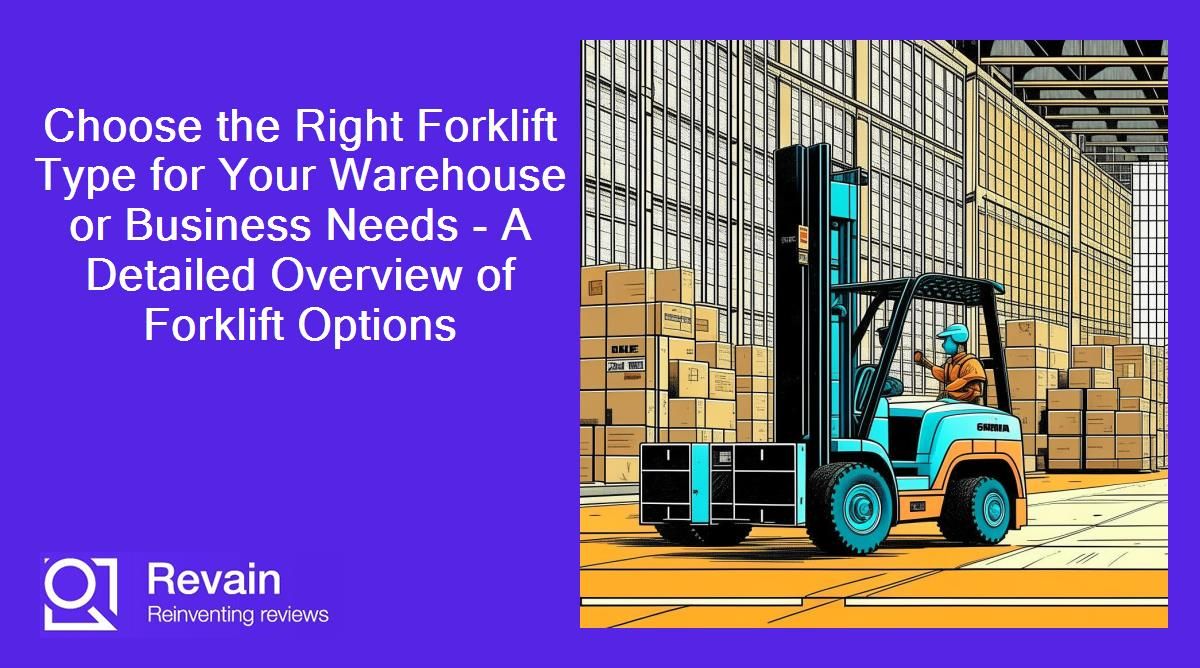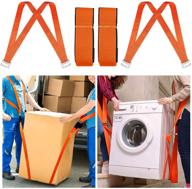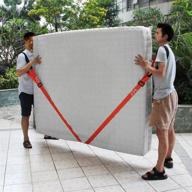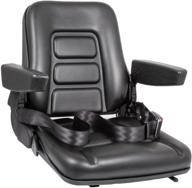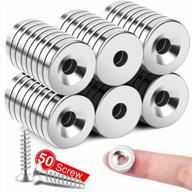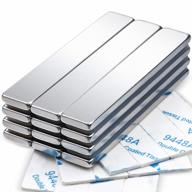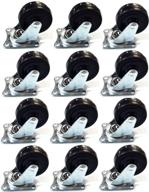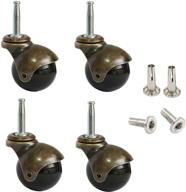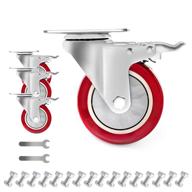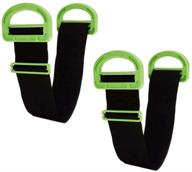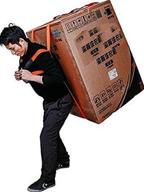Top products in 🚜 Forklifts
Types of Forklifts
Forklifts, also known as lift trucks, are powered industrial trucks used to lift and transport materials over short distances. There are several different types of forklifts designed to handle different capacities and warehouse environments.
Similar products
Counterbalance Forklifts
Counterbalance forklifts are the most common type of forklift. They use a counterweight in the rear of the vehicle to counterbalance the weight of the load on the forks. This allows the forklift to remain stable when lifting heavy loads. Counterbalance forklifts can be powered by internal combustion engines that run on gasoline, diesel, LP gas, or compressed natural gas. Electric counterbalance forklifts are also available.
- Class 1: Hand or Electric Pallet Trucks (3,000 lb capacity)
- Class 2: Narrow-Aisle Forklifts (3,000 - 5,000 lb capacity)
- Class 3: Electric Motor Rider Forklifts (6,000 - 15,000 lb capacity)
- Class 4: Internal Combustion Engine Forklifts (15,001 - 25,000 lb capacity)
- Class 5: Internal Combustion Engine Trucks (25,001 - 60,000 lb capacity)
Another interesting products
Reach Forklifts
Reach forklifts use telescopic forks that can extend forward to reach into racking. This allows them to store and retrieve pallets without having to reposition the truck. The stability comes from the outriggers extending from the front wheels rather than a counterweight. Reach forklifts are ideal for narrow aisle warehouses.
Side Loader Forklifts
Side loader forklifts access their load from the side rather than the front. This allows them to be used in warehouses where space is limited. The forks slide underneath the load and lift it off the ground for easy transport.
Order Picker Forklifts
Order picker forklifts are designed to pick individual items off shelves and pallets. They have an elevating platform that brings the operator to the level of the load so they can manually move items onto or off of the forks. Order pickers excel at precision handling of lighter loads.
Rough Terrain Forklifts
Rough terrain forklifts are built to handle outdoor job sites, especially on uneven surfaces. They have rugged tires and increased ground clearance. These forklifts are optimal for construction sites, lumber yards, and loading docks.
When selecting a forklift, it's important to consider the types of loads you'll be handling, aisle width, ground surface, and height of lifting. Consulting with a knowledgeable forklift dealer will help you find the right model for your specific application.
Choosing the Right Forklift for Your Needs
Selecting the appropriate forklift for your warehouse or operation is an important decision. The right forklift can improve efficiency, safety, and productivity. Here are some key factors to consider when choosing a forklift:
Capacity
Consider the weights and dimensions of the loads you need to lift. Forklift capacity is rated in pounds. Make sure to pick a forklift with enough capacity to handle your heaviest loads, while allowing for future growth.
Lift Height
The lift height is the maximum height the forks can reach when the mast is fully extended. Pick a forklift that can reach your tallest racks or stacks.
Fork Length
Fork length determines how far back into racks and pallets the forks can reach. Measure your skid dimensions and rack openings and select forks at least 2 inches longer.
Tire Type
- Pneumatic tires: Designed for outdoor use on uneven surfaces. Good traction and cushioning.
- Solid tires: Last longer than pneumatic tires and don't go flat. Good for indoor flat floors.
- Cushion tires: Provide cushioning similar to pneumatic tires but don't require air.
Power Source
- Electric: Best for indoor use. No emissions. Lower maintenance.
- Internal combustion engine: Powerful but produce emissions. Require fueling and engine maintenance.
- Fuel cell: Use hydrogen power. Produce only water. Higher upfront cost.
Drive Type
- Sit-down: Rider sits in compartment. Better visibility.
- Stand-up: Operator stands on platform. Fast pace.
- Walkie: Walk alongside as it drives. Good maneuverability.
- Ride-on pallet jack: Ride on platform. Light loads.
Choosing the right forklift takes research and planning. Consider working with a knowledgeable forklift dealer that can help you select the ideal model to maximize productivity and meet your specific application needs.
Forklift Maintenance Tips
Proper maintenance keeps your forklift in top working condition for safety and performance. Follow these tips to maintain your forklift and extend its life:
Inspect Daily
Conduct a daily walk-around to check for issues that could impact operations or safety:
- Check tires for adequate pressure and signs of damage or uneven wear.
- Look for fluid leaks under the forklift.
- Test lift and tilt functions.
- Inspect mast chains for looseness.
- Check hydraulic hoses and cylinders.
Follow the Service Schedule
Follow the manufacturer's guidelines for periodic service intervals. Key maintenance tasks include:
- Changing engine oil and filter.
- Replacing air and fuel filters.
- Checking transmission fluid.
- Inspecting steer axle and mast pivot points.
- Cleaning battery terminals and checking fluid levels.
Address Any Issues
Investigate leaks, unusual noises or changes in performance immediately. Small issues can lead to bigger problems if left unchecked.
Keep Fluids Topped Off
Check oil and fluid levels frequently and refill as needed. Low fluid levels can cause damage.
Check Hydraulic System
Inspect hoses and fittings for leaks or loose connections. Maintain proper hydraulic fluid levels. Test lift/tilt speed - slower than normal could indicate issues.
Inspect Tires
Look for cuts, gouges and uneven tread wear. Rotate tires occasionally to extend wear. Check and adjust air pressure.
Clean Regularly
Remove debris and grease buildup. Clean overhead guard and covers. Ensure pedals, steps and grab bars are free of dirt and oils.
Check Safety Equipment
Test horn, gauges, warning lights, seat belts, mirrors and back-up alarms. Ensure load backrest is secure. Replace worn or missing safety labels.
Adhering to a routine maintenance schedule protects your investment and keeps operators safe. Consult your forklift operator's manual or work with a certified technician for additional recommendations.
How Forklifts Work
Forklifts are powered industrial trucks used to lift and transport materials over short distances. Here is an overview of how the various components and systems allow a forklift to perform its critical warehouse functions:
Power Source
Forklifts are powered by an internal combustion engine running on gasoline, diesel or propane, or an electric motor drawing current from batteries. The power source supplies energy to drive the hydraulic lifting system and drivetrain.
Drivetrain
The drivetrain transmits engine power to the wheels through a transmission, drive shaft, differential and axles. This allows the operator to steer and propel the forklift.
Hydraulic System
Hydraulic power is essential for performing lifting and tilting functions. An engine-driven hydraulic pump pushes fluid into cylinders to raise, lower and tilt the mast. Control valves direct the fluid flow to execute movements.
Mast
The upright mast structure provides stability and allows the carriage and forks to be raised to pick up loads. A roller chain pulley system lifts the carriage along the mast.
Carriage
The carriage is the component that slides up and down the mast to lift loads on the forks. The hydraulic cylinders connect to the carriage to control vertical movement.
Forks
Forks slide under the pallet or object to be lifted. Forks are usually 42-48 inches long and spaced 6-9 inches apart. The carriage tilts the forks forward and backward to pick up and deposit loads.
Counterweight
Counterbalance forklifts have a heavy counterweight built into the rear of the truck. This provides stability against the weight of the load on the forks to prevent the truck from tipping forward.
Operator Compartment
Sit-down forklifts have a protected cab with controls, seat, steering wheel or levers, and pedals for the operator. Standing forklifts have an open platform with controls.
Understanding how each component contributes to the overall function allows for better operation and maintenance of forklifts.
Forklift Operator Training
Proper forklift training is crucial for safe operations and preventing accidents in the workplace. Here are some key elements of an effective forklift operator training program:
Classroom Training
Classroom training provides foundational knowledge through lectures, videos and discussions. Key topics include:
- Forklift parts, controls and instrumentation
- Center of gravity and load stability
- Refueling and battery charging procedures
- Inspection and maintenance requirements
- Hazard avoidance and accident prevention
Practical Training
Hands-on training is essential for developing forklift operating skills:
- Mounting and dismounting procedures
- Maneuvering the forklift forwards, backwards and laterally
- Picking up, driving and depositing loads
- Stacking and destacking loads on racks
- Handling loads on ramps and docks
Safety Protocols
Operators must understand all organizational safety rules and regulations, including:
- Right-of-way procedures
- Speed limits and zones
- Required personal protective equipment
- Load capacity limits
- Hazardous material handling
Evaluation
At the end of training, operators should pass a hands-on driving test to confirm proficiency. Operators should also undergo periodic refresher training to maintain and enhance skills.
Certification
Many employers and jurisdictions require forklift operators to earn a license or certification after completing training. This helps demonstrate their qualifications.
Proper forklift training teaches operators the skills and knowledge needed to handle equipment safely and productively.
Top Forklift Brands and Models
Several brands stand out in the forklift market for their popularity and reliable equipment. Here are some of the top forklift manufacturers and their notable model lines:
Toyota
Toyota is the global leader in forklift sales and is known for durability and reliability. Popular Toyota forklift models include:
- 8-Series: Rugged four-wheel electric counterbalance forklifts.
- 7-Series Reach Trucks: Narrow aisle trucks for high density warehousing.
- Walkie Stackers: Compact pedestrian operated pallet stackers.
Hyster
Hyster is a leading brand of combustion and electric forklifts. Well-known Hyster models include:
- H160-190FT: Tough series for demanding applications.
- S155-170FT: Low noise level for indoor operation.
- J230-360FT: High capacity diesel pneumatic tire forklift.
Crown
Known for superior ergonomics and safety, popular Crown forklifts include:
- Wave: Sit-down counterbalance truck with excellent visibility.
- SP Series: Order pickers to optimize warehouse picking.
- SC Series: Stand-up counterbalanced trucks for productivity.
Yale
Key Yale forklift models include:
- NR/NP Series: Electric rider pallet trucks for narrow aisles.
- MS Series: Reach trucks for high storage density.
- GP/GLP Series: Heavy-duty internal combustion engine forklifts.
Raymond
Top Raymond forklift product lines include:
- 9200 Orderpicker: Allows precise, hands-free order picking.
- 9700 Reach-Fork: Narrow chassis reach trucks.
- 9900 Swing-Reach: Flexible side loaders for dock work.
These leading brands offer a wide selection of forklift models to meet diverse material handling needs.
Tips for Purchasing Forklifts on Amazon Business
Amazon Business offers a wide selection of new and used forklifts available for purchase. Here are some tips for effectively buying forklifts on Amazon Business:
- Check seller ratings and reviews to ensure a reputable supplier.
- Compare prices across sellers to find the best deal.
- Look for free shipping or Amazon Fulfillment options.
- Search by features like capacity, lift height, tire type to find the right model.
- Check if financing and leasing options are available.
- Read product details and specifications carefully before purchase.
- Consider warranty, returns policy and after-sales support.
By doing your research and reading customer feedback, you can feel confident buying a quality forklift on Amazon Business at a competitive price point.
Using Amazon Prime for Forklift Parts Supplies
For forklift parts and accessories, an Amazon Prime subscription can provide:
- Free two-day shipping on millions of eligible parts and supplies.
- Quick reordering of routine consumables like tires, batteries.
- Easy price comparisons to get the best deals.
- Convenient delivery instead of pickup at local suppliers.
Amazon Prime can help forklift owners and operators access the parts they need quickly and affordably. This allows companies to maintain their lift truck fleets and keep them running productively.
Let me know if you would like me to generate content on any other related topics!p>What Are The Different Types Of Forklifts And Their Uses?
Forklifts are essential vehicles for carrying heavy loads that humans cannot move safely and efficiently alone. There are many different types of forklifts, each designed for specific applications and offering unique benefits and features. Here are some of the most common types of forklifts and their uses:
- Warehouse forklift: Used for loading and unloading pallets and transporting items to and from delivery vehicles in facilities with many items in inventory.
- Side loader forklift: Used for loading and unloading long and bulky items, such as pipes and timber, from the side.
- Counterbalance forklift: Used for situations requiring circular maneuvering and for lifting heavy loads.
- Telehandler forklift: Used for indoor and outdoor applications with rough surfaces.
- Rough terrain forklift: Used for construction sites, uneven ground, and high-elevation lifting.
- Pallet jack: Used for moving pallets short distances.
- Reach truck: Used for quick and precise pallet picking in indoor situations.
- Order picker: Used for picking orders from high shelves.
- Industrial forklift: Combines the functionality of a telehandler with that of a warehouse forklift and is used for hauling much heavier loads to greater heights than a warehouse forklift.
Forklifts vary in size depending on their function, and their types vary in several aspects, from their fuel type and tire to their classification. OSHA has defined seven forklift classes in order for forklift operators to be fully certified and prepared to operate the distinct vehicles.
What Is The Difference Between A Counterbalance Forklift And A Reach Truck?
Counterbalance forklifts and reach trucks are two types of forklifts that are used for different applications. Here are some of the differences between the two:
Counterbalance forklifts:
Reach trucks:
What Are The Weight Limits For Counterbalance Forklifts And Reach Trucks?
Counterbalance forklifts and reach trucks are two types of forklifts that are used for different applications. Here are some of the differences between the two:
Counterbalance forklifts:
Reach trucks:
In summary, counterbalance forklifts are designed for horizontal distance transfer of heavy goods, while reach trucks are designed for vertical distance transfer of goods from extended heights. Counterbalance forklifts can handle heavier loads, while reach trucks are more maneuverable in narrow spaces.






